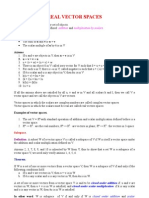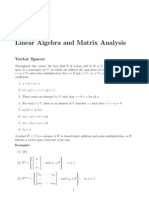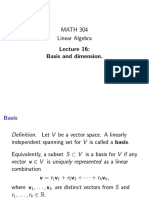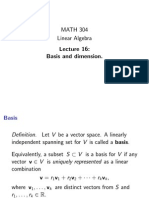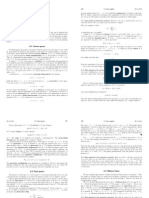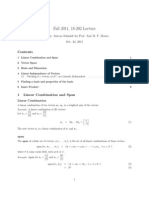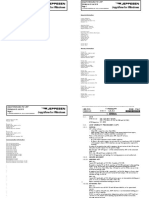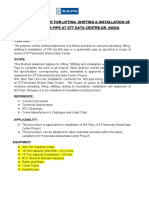Linear Combinations, Basis, Span, and Independence Math 130 Linear Algebra
Uploaded by
Cody SageLinear Combinations, Basis, Span, and Independence Math 130 Linear Algebra
Uploaded by
Cody SageLinear Combinations, Basis, Span, and Independence Math 130 Linear Algebra
D Joyce, Fall 2012 Were interested is pinning down what it means for a vector space to have a basis, and thats described in terms of the concept of linear combination. Span and independence are two more related concepts. Generally, in mathematics, you say that a linear combination of things is a sum of multiples of those things. So, for example, one linear combination of the functions f (x), g(x), and h(x) is 2f (x)+3g(x) 4h(x).
A basis for a vector space. You know some bases for vector spaces already even if you havent know them by that name. For instance, in R3 the three vectors i = (1, 0, 0) which points along the x-axis, j = (0, 1, 0) which points along the y-axis, and k = (0, 0, 1) which points along the z-axis together form the standard basis for R3 . Every vector (x, y, z) in R3 is a unique linear combination of the standard basis vectors (x, y, z) = xi + yj + zk.
Thats the one and only linear combination of i, j, and k that gives (x, y, z). (Why?) Well generally use Greek letters like and to distinguish bases (bases is the plural of basis) from other subsets of a set. Thus = {i, j, k} is the standard basis for R3 . Well want our bases to have an ordering to correspond to a coordinate system. So, for this basis of R3 , i comes before j, and j comes before k. Denition 1 (Linear combination). A linear comThe plane R2 has a standard basis of two vectors, bination of vectors v1 , v2 , . . . , vk in a vector space namely, = {i, j} where i = (1, 0) and j = (0, 1). V is an expression of the form (Although were using i and j for dierent things, you can tell whats meant by context.) c1 v 1 + c2 v 2 + + ck v k There is an analogue for Rn . Its standard basis is where the ci s are scalars. More generally, if S is a = {e1 , e2 , . . . , en } set of vectors in V , not necessarily nite, then a linear combination of S refers to a linear combination where e1 = (1, 0, . . . , 0), of some nite subset of S. e2 = (0, 1, . . . , 0), ... Alternatively, we could dene a linear combinaen = (0, 0, . . . , 1). tion of vectors is a sum of scalar multiples of them. Of course, dierences are allowed, too, since negaSometimes its nice to have a notation without tions of scalars are scalars. the ellipsis (. . .), and the Kronecker delta symbol We can use linear combinations to characterize helps here. Let ij be dened by subspaces. 1 if i = j ij = Theorem 2. A nonempty subset W of a vector 0 if i = j space V is a subspace of V if and only if W is closed under linear combinations, that is, whenever Then the j th coordinate eij of the ith standard unit w1 , w2 , . . . , wk all belong to W , then so does each vector is ij . linear combination c1 w1 +c2 w2 + +cn wk of them Coordinates are related to bases. Let v be a vecbelong to W . tor in Rn . It can be uniquely written as a linear 1
combinations of the standard basis vectors v = v1 e1 + v2 e2 + + vn en
So the -coordinates of v are [v] = v1 + v2 v1 v2
and the coecients that appear in this unique linear So, for instance, the vector which has standard cocombination are the coordinates of v 3 ordinates (2, 4) has the -coordinates 1 v = (v1 , v2 , . . . , vn ). There are lots of other bases for R2 . In fact, if That leads us to the denition of for the concept of basis of a vector space. Whenever we used a you take any two vectors b1 and b2 that dont lie basis in conjunction with coordinates, well need an on a line, theyll form a basis. ordering on it, but for other purposes the ordering Math 130 Home Page at wont matter. http://math.clarku.edu/~djoyce/ma130/ Denition 3. An (ordered) subset = {b1 , b2 , . . . , bn } of a vector space V is an (ordered) basis of V if each vector v in V may be uniquely represented as a linear combination of vectors from v = v1 b1 + v2 b2 + + vn bn . For an ordered basis, the coecients in that linear combination are called the coordinates of the vector with respect to . Later on, when we study coordinates in more detail, well write the coordinates of a vector v as a column vector and give it a special notation v1 v2 [v] = . . . vn Although we have a standard basis for Rn , there are other bases. Example 4. For example, the two vectors b1 = (1, 1) and b2 = (1, 1) form a basis = (b1 , b2 ) for R2 . Each vector v = (v1 , v2 ) can be written as a unique linear combination of them, namely v = (v1 , v2 ) = 1 (v1 + v2 )b1 + 1 (v1 v2 )b2 . 2 2 2
You might also like
- Scribble Magazine Issue 12 1999 eBook-AEROHOLICS PDF100% (1)Scribble Magazine Issue 12 1999 eBook-AEROHOLICS PDF29 pages
- Modul 5-B_GVS Linear Dependence-editedAruni EnglishNo ratings yetModul 5-B_GVS Linear Dependence-editedAruni English34 pages
- 5.2 Vector spaces, linearly independent, dependent, basisNo ratings yet5.2 Vector spaces, linearly independent, dependent, basis16 pages
- MATH 4A - Linear Algebra With Applications: Lecture 3: Vector and Matrix EquationsNo ratings yetMATH 4A - Linear Algebra With Applications: Lecture 3: Vector and Matrix Equations27 pages
- Linear Algebra and Matrix Analysis: Vector SpacesNo ratings yetLinear Algebra and Matrix Analysis: Vector Spaces19 pages
- Topic 5 Linear Combination Linear Dependence Spanning, Orthogonal-WordNo ratings yetTopic 5 Linear Combination Linear Dependence Spanning, Orthogonal-Word12 pages
- MATH 304 Linear Algebra Basis and DimensionNo ratings yetMATH 304 Linear Algebra Basis and Dimension16 pages
- Lecture 19 Dimension & Row Space and Column SpaceNo ratings yetLecture 19 Dimension & Row Space and Column Space40 pages
- MATH 4A - Linear Algebra With Applications: Lecture 17: Linear Independence, Bases, and Coordinate SystemsNo ratings yetMATH 4A - Linear Algebra With Applications: Lecture 17: Linear Independence, Bases, and Coordinate Systems25 pages
- Linear Dependence and Linear Independence: 32. 33. Prove That If S and S 34. Prove ThatNo ratings yetLinear Dependence and Linear Independence: 32. 33. Prove That If S and S 34. Prove That15 pages
- Introduction To Continuum Mechanics Lecture Notes: Jagan M. PadbidriNo ratings yetIntroduction To Continuum Mechanics Lecture Notes: Jagan M. Padbidri26 pages
- Introduction To Continuum Mechanics Lecture Notes: Jagan M. PadbidriNo ratings yetIntroduction To Continuum Mechanics Lecture Notes: Jagan M. Padbidri33 pages
- Basics of Affine Geometry 2.1 Affine SpacesNo ratings yetBasics of Affine Geometry 2.1 Affine Spaces19 pages
- Linear Combination: 3.4 Linear Dependence and Span P. DanzigerNo ratings yetLinear Combination: 3.4 Linear Dependence and Span P. Danziger14 pages
- Linear Transformations and Matrices Math 130 Linear AlgebraNo ratings yetLinear Transformations and Matrices Math 130 Linear Algebra4 pages
- Math 110: Linear Algebra Homework #11: David ZywinaNo ratings yetMath 110: Linear Algebra Homework #11: David Zywina19 pages
- Some Linear Transformations On R Math 130 Linear AlgebraNo ratings yetSome Linear Transformations On R Math 130 Linear Algebra5 pages
- Linear Differential Equations Math 130 Linear AlgebraNo ratings yetLinear Differential Equations Math 130 Linear Algebra2 pages
- Matrix Inversion Math 130 Linear AlgebraNo ratings yetMatrix Inversion Math 130 Linear Algebra2 pages
- Math 110: Linear Algebra Homework #8: David ZywinaNo ratings yetMath 110: Linear Algebra Homework #8: David Zywina8 pages
- Math 110: Linear Algebra Homework #4: David ZywinaNo ratings yetMath 110: Linear Algebra Homework #4: David Zywina9 pages
- Norm and Inner Products in R Math 130 Linear AlgebraNo ratings yetNorm and Inner Products in R Math 130 Linear Algebra3 pages
- Homework 5 Solutions: 2.4 - Invertibility and IsomorphismsNo ratings yetHomework 5 Solutions: 2.4 - Invertibility and Isomorphisms4 pages
- Math 110: Linear Algebra Homework #12: Chu-Wee LimNo ratings yetMath 110: Linear Algebra Homework #12: Chu-Wee Lim4 pages
- Math 110: Linear Algebra Homework #10 Problem (1) - Use Induction On The Dimension N of A To Prove That Det (A Xi) Is A PolyNo ratings yetMath 110: Linear Algebra Homework #10 Problem (1) - Use Induction On The Dimension N of A To Prove That Det (A Xi) Is A Poly4 pages
- Math 110: Linear Algebra Homework #7: 2.6: Dual SpacesNo ratings yetMath 110: Linear Algebra Homework #7: 2.6: Dual Spaces8 pages
- Homework 7 Solutions: 5.2 - DiagonalizabilityNo ratings yetHomework 7 Solutions: 5.2 - Diagonalizability7 pages
- Homework 4 Solutions: 2.2 - The Matrix Representation of A Linear TransformationNo ratings yetHomework 4 Solutions: 2.2 - The Matrix Representation of A Linear Transformation4 pages
- Math 110: Linear Algebra Homework #3: Farmer SchlutzenbergNo ratings yetMath 110: Linear Algebra Homework #3: Farmer Schlutzenberg13 pages
- Homework 1 Solutions: 1 2.1 - Linear Transformations, Null Spaces, and RangesNo ratings yetHomework 1 Solutions: 1 2.1 - Linear Transformations, Null Spaces, and Ranges4 pages
- Placement Project BMIH6006.8 - Autumn Term 2023 Handbook FINAL KF EE PDFNo ratings yetPlacement Project BMIH6006.8 - Autumn Term 2023 Handbook FINAL KF EE PDF20 pages
- Service Manual: Valeo TM08, TM13, TM15 & TM16 CompressorsNo ratings yetService Manual: Valeo TM08, TM13, TM15 & TM16 Compressors56 pages
- AN 259 IC N Methylpyrrolidine Cefepime LPN2586 ENNo ratings yetAN 259 IC N Methylpyrrolidine Cefepime LPN2586 EN6 pages
- BSL Method Statememt For Lifting Thermal Tank - 1No ratings yetBSL Method Statememt For Lifting Thermal Tank - 14 pages
- MCE_Cambridge_Primary_Science_2E_Stage6_RM_C01 (2)No ratings yetMCE_Cambridge_Primary_Science_2E_Stage6_RM_C01 (2)11 pages
- Chapter 1 Philosophical Perspective of The Self What Is Understanding Self PDF FreeNo ratings yetChapter 1 Philosophical Perspective of The Self What Is Understanding Self PDF Free10 pages
- Principles Involved in Handwriting Identification100% (3)Principles Involved in Handwriting Identification2 pages
- IC6501 SCAD MSM by WWW - Learnengineering.inNo ratings yetIC6501 SCAD MSM by WWW - Learnengineering.in223 pages
- LESSON-3 History of Global Politics Creating An International Order100% (1)LESSON-3 History of Global Politics Creating An International Order40 pages




